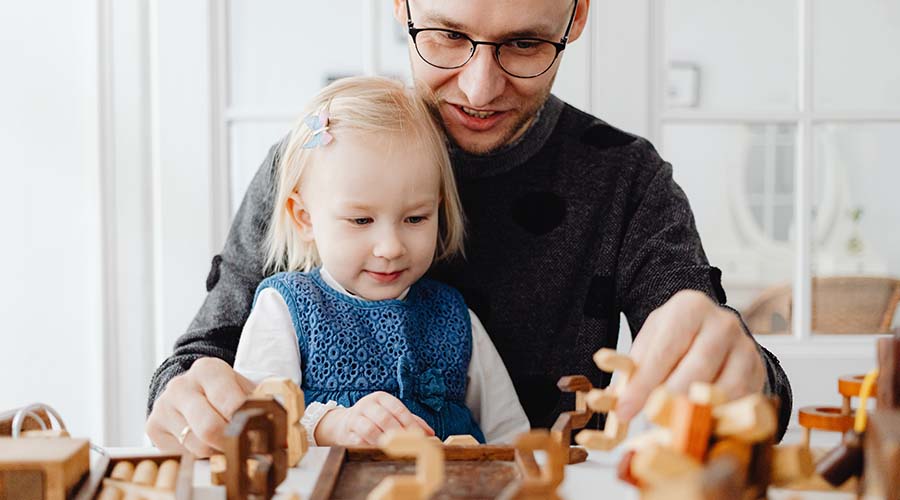settings
children
With Famly since
When we think about how we address speech difficulties in the Early Years, it’s not just about what the children are going to do. A lot of this process rests on us adults — and with the way we observe, assess and respond to the speech difficulties we find in our settings.
As we’ve said before, Jo and I have long been supporters of the Wellcomm Early Years toolkit for strengthening our understanding of speech difficulties in the Early Years. In our opinion, Wellcomm should be routinely used as a “first line of defence” when it comes to addressing speech and language difficulties.
Why use Wellcomm to support speech and language development?
- It’s designed for the right age group, from the ground up.
- It gives a baseline measurement of children’s abilities, and opportunities to compare new assessments as children grow and develop.
- It virtually eliminates the need for practitioners to make judgements about whether a child ‘has got it or not’.
- It tells you exactly what to do to help!

Making the most of Wellcomm to support language skills
Over the years, we at Soundswell have adapted and enhanced Wellcomm so that practitioners are beginning to look at possible reasons why children are behind. If you look back to the second article in this series, you can get a quick refresher on the steps we follow:
- What to do,
- Why to do it,
- How to recognise if it isn’t working,
- When to seek help from a specialist, such as a speech and language therapist.
If practitioners can take ownership of these crucial stages, it makes it easier to identify a delay in a child's language development earlier on, which gives them more time to make improvements.
In turn, more children will progress out of the ‘danger zone,’ and we will have an easier time identifying the children experiencing long-term difficulties, so that we can connect them with specialist help before they get to Reception.
What kind of language development progress to expect
At the end of article one we said: ‘pretty much every child will make progress’.
Some will make dramatic progress, and will no longer be a cause for concern. This group will probably be those where the ‘nature’ component is working fine but the ‘nurture’ aspects may have fallen short.
Others will make some progress — it may be that their language skills are below average, other communications skills work just fine. Then, there will be a few whose progress is minimal. In these cases, there may be underlying problems that are contributing to the child’s difficulties. These will be the children who need more than a universal approach.
We’re going to take a look at some examples of real cases, which help to illustrate the different kinds of issues you will encounter, what you might do, and how you can measure progress. These materials are part of the Soundswell enhanced Wellcom training, which you can learn more about here.
Assessing a child’s speech and language needs
Down below we’ve got a sample table, drawn from real assessments, that gives you an idea of how you can assess and organize your children’s language skills and needs.
Once you have screened your children, you can organise your data into a chart similar to the one below. You’ll note that children’s ages are not sequential — this is because we’re organising it by rank of the greatest language needs first. This way, we can order our priorities a little better.
Here’s how we fill this out:
- Column B: The child’s age (in months) at time of screening
- Column C: Calculation of the gap between chronological age & language ‘age’, determined as part of the Wellcomm training.
- Column D: This is where you write down more information, such as ideas on why the child’s language score is what it is.
- Column E: What interventions and support are you going to do?
| A | B | C | D | E |
| Name | Age (months) | +/- | Narrative (more information about the child) | Action (examples of what to do) |
| Child 1 | 48 | -19 | Thought to be primarily EAL | General nursery language activities + monitor + revisit in 4 months |
| Child 4 | 39 | -15 | Immature. Concerns re: general development | SLT assessment + attention & listening group + include in a targeted group |
| Child 5 | 46 | -11 | Good non-verbal skills, frustrated/behaviour problems | SLT full assessment – maybe specific language disorder + include in targeted group |
| Child 3 | 44 | -9 | Suspected lack of early play & language opportunities | General nursery language activities + include in targeted group |
| Child 2 | 47 | = | Age appropriate | General nursery language activities |
Grouping children by language development needs
Once you’ve got this first table in order, the next step is to group children together by the form of interventions or support you’ve got planned for them. You should be careful to not just group every high-priority child together — instead, look for the reasons why they need help.
A child who is very behind in English because English isn't their native language will need something different from a child with cognitive difficulties, like autism spectrum disorders, for example.
Then, the next step is to proceed with your interventions using the Wellcomm ‘Big Book of Ideas’ – everything is there for you.

Measuring progress in children's developing language
At the point which best suits your setting, it’s time to do another screening, just like the one above. Remember, the whole point is to allow time and opportunity for children to make progress and so you can embed your strategies for language effectively. Leave time to deliver those early language development interventions.
Always re-screen everyone if you can, even children whose speech and language abilities are age-appropriate or even advanced. This is as a safety net, to make sure nobody’s falling behind. Occasionally a child’s language and speech development progress will falter at a specific point, and if you don’t re-screen everyone, you risk missing that.
Below, we’ve got an example of a table used to compare children’s original scores with the results from the re-screen. You can add additional columns for later re-screens, too, repeating this as much as you need.
| Name | Age (months) at first screen | Score at first screening, October 2018 +/- | Age (months) at rescreen | Score at second screening, March 2019 +/- |
| Child 1 | 48 | -19 | Don’t forget that children will be X months older so scores will be calculated based the age they are at rescreen. See Wellcomm for more details. | -4 |
| Child 4 | 39 | -15 | Don’t forget that children will be X months older so scores will be calculated based the age they are at rescreen. See Wellcomm for more details. | -11 |
| Child 5 | 46 | -11 | Don’t forget that children will be X months older so scores will be calculated based the age they are at rescreen. See Wellcomm for more details. | = |
| Child 3 | 44 | -9 | Don’t forget that children will be X months older so scores will be calculated based the age they are at rescreen. See Wellcomm for more details. | +1 |
| Child 2 | 47 | = | Don’t forget that children will be X months older so scores will be calculated based the age they are at rescreen. See Wellcomm for more details. | Not rescreened |
Evaluating the results of your language and speech development rescreening
Let’s just take a moment to look at whether scores have improved, and if so, by how much. It’s also important to reflect on why we aren’t making progress, if you don’t see that reflected in your re-screenings.
- Child 1: Terrific progress. Their score has risen significantly since the first screening, following the predicted pathway for a child who has English as an additional language.
- Child 4: Some progress, but all quite caught up. This suggests that your initial suspicions about general learning levels are probably correct.
- Child 5: Good progress, and is now at an age-appropriate level of speech and language development, for their age at the time of the re-screening.
- Child 3: Excellent gains. This child has significantly benefited from your nurturing in regard to their language development.
- Child 2: Began as age-appropriate, and in this instance, was not re-screened.
As you carry out this re-screening exercise for the second and third time, your knowledge and skills will be far greater, and your results will be more reliable.
You’ll find that you prove your hunches right more often than not, and will increase in confidence in terms of how you assess and address speech and language development difficulties.

Making sure the speech and language development progress sticks
As you carry out these assessments and screenings, be alert for the children who make minimal or no progress, and the occasional instance where a child's ability has regressed. This does happen, and it’s as good a cause for alarm as the huge gains are cause for celebration.
When there is no change or possibly a child seems to have ‘gone backwards’, it’s really important to try and find out why.
Revisit the narrative column from the start, where you remark on why the child might be experiencing difficulties, and reflect on the information you have there. Now decide what action to take – it may be that more of the same is not necessarily the answer!
Draw upon the knowledge you now have to create the best course of action:
- The type & severity of the problem(s): language delay, the child's attention, how they pronounce words, their speech sounds, do they engage with simple instructions, can they repeat words, are they talking differently depending on where they are etc.
- Possible causes: little previous opportunity for language learning, a developmental language disorder, early childhood trauma, cognitive development delays etc.
- And, if known, secondary issues: what else is going on in that child's life?
What other action can I take to support developing language in the Early years?
- Continue to use the Wellcomm Big Book of Ideas, but on an individual basis and more intensely.
- Look in much more detail at non-verbal skills, not just oral language. Could there be general communication problems, rather than just language problems? Consider other communication skills such as facial expressions, body language, how they play games with other children etc. Do they use sign language?
- Is the child on par with their peers in other areas of the curriculum? Of course, children develop at different rates, but are they just behind in terms of language? This could point to potential other factors.
- Look at strengths as well as weaknesses. What does the child excel at, and could we use those strengths to help build in the areas where they’re lagging behind? Language development in children is so important but if there is a delay, don't forget to celebrate the areas the child is really good at and what they're interested in.
- Chat with the child’s parents and answer questions they might have. Parents may not be hugely familiar with child development and may not realise their child could have a language delay. Are they worried? How do they feel about their child's vocabulary? How is the child performing at home? If they have no worries and report lots of language use and comprehension, encourage them to bring in some phone footage for you to see. This might shed some light on the issue.
- Did you suspect EAL (English as an additional language), but find that the child has made minimal progress? EAL children can also have learning difficulties, or other coexisting needs, too. Encourage children and parents to continue to use their home language and work together to monitor speech and language development.
- Check whether a child has been absent more than usual. Have they missed a lot of your planned interventions or support programmes? Appropriate and effective communication interventions can only work if the child is there to engage with them.
- Check which intervention group the child was placed in. Might they have been better managed in another way, perhaps? Click here for information about running Attention & Listening groups.
- Talk to your team leader or SENDCo. It might be time to escalate your concerns to a speech and language therapist, for example. You will have plenty of evidence to help them from the work you have done so far.
Tackling language development in the Early Years
Through these three articles, we hope you’ve gained a stronger understanding of what can cause children to fall behind in their speech and language skills, what that looks like in your setting, and what you can do to help.
Of course, there’s still a great deal more to learn, and many more resources to reach out to. This is just a start.
Remember, you could also refer to speech and language therapy, if you feel it’s necessary in some instances. Just because this is a scarce resource, doesn’t mean you should give up on making referrals!
Diana McQueen and Jo Williams are the Directors of Soundswell, an Early Years speech and language therapy service offering both direct therapy as well as consultancy services. You can visit the Soundswell website to learn more about their work.
The big ideas
Try learning journals for free
Add observations, and build digital learning journals to share with families instantly. All with your completely free 14-day trial.
Get started









